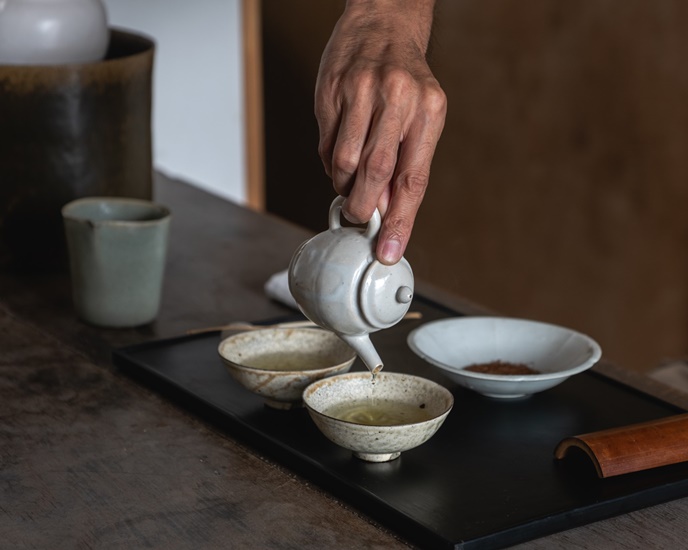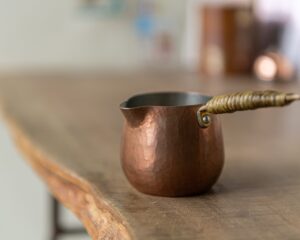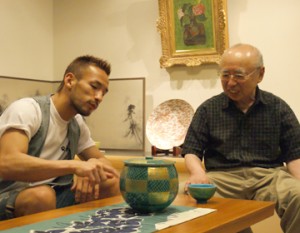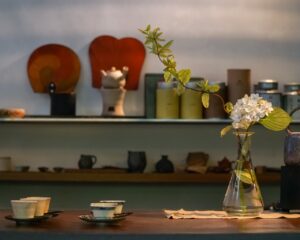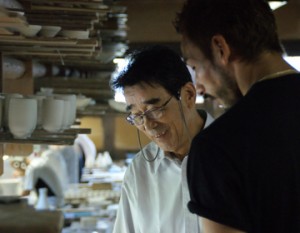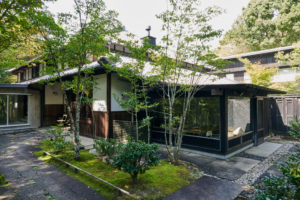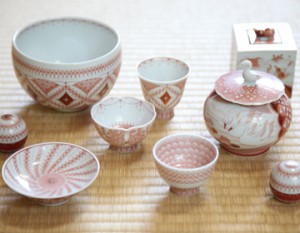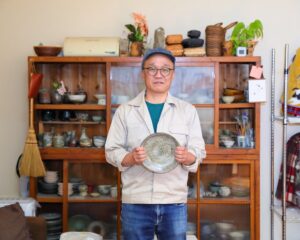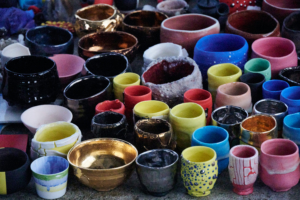Located in the northwest of Oita Prefecture, Hita City is rich in nature. Ceramic artist Osamu Mitoma uses the ash and soil of Hita to create glazes, crafting vessels that accompany people’s lives. Pursuing and expressing the “beautiful” and “charming” things born in everyday life, Mitoma continues to create.
Encounter with pottery

n 2007, Osamu Mitoma built a kiln in his hometown of Hita. He spent his high school years in Hita and, driven by a desire to study design, he enrolled in the Faculty of Education at Tokyo Gakugei University, majoring in art. At the time, he was interested in industrial design, such as cars, but during his university years, he encountered pottery in a class when he was struggling with his future, inspired by talented individuals. He became increasingly fascinated and immersed in its appeal. Kyushu, where he was born and raised, is also renowned for pottery. In Hita, there is the inherited tradition of “Ko-Onta Ware” and the internationally popular “Arita Ware” from Saga Prefecture nearby. Although the style of Mitoma’s work differs, pottery has always been familiar to him since childhood. The encounter between Mitoma and pottery, leading him to return to his hometown and establish a studio, may not have been entirely coincidental.
The fluctuations expressed in “Mold Making”

Mitoma’s primary technique is “mold making.” He creates vessels solely through molding or hand-building techniques, without using a potter’s wheel. Although he experienced using a potter’s wheel during university classes, he found it unsuitable because it takes several years to master the technique and there is often a significant gap between the ideal image in one’s mind and the actual outcome. To find his own style, he read various magazines and visited exhibitions, eventually discovering “mold making.” Around the same time, he had the opportunity to see the works of Living National Treasure Munemaro Ishiguro in Kyoto. Among his works were those made using molds, and Mitoma intuitively felt that “this is it,” which became the deciding factor. He then became an apprentice to a mold-making master in Kyoto and began to earnestly learn the craft.
“The nuances created by hand”
Mitoma’s process of creating pottery begins with sketching out his ideas and designing them. He shapes the clay into a prototype while comparing it to the three-dimensional image he has in mind, then takes a mold with plaster. By assembling and pressing the molds together by hand, he smoothens out each piece, particularly thinning out the mouth of the vessel significantly, which is one of his distinctive features. Moreover, he intentionally makes the base thicker to ensure a better feel when holding the vessel, with the center of gravity lower for a more comfortable grip. While this method is time-consuming due to its manual nature, he persists in it because it allows him to express the unique “fluctuations” inherent in mold making. Mold making involves tapping the material onto the mold, causing particles to scatter and irregularities to form, resulting in unpredictable movements after firing. While fluctuations can also occur when using a potter’s wheel, Mitoma believes that the relaxed rhythm, finger pressure, and time spent on mold making contribute to the distinctiveness of his work. The soft undulations and beautiful distortions that characterize the allure of Mitoma’s vessels are all born from the process of crafting everything by hand.
Committing to not being committed.

“Committing to the absence of commitment” is a key aspect of Mitoma’s creations, where no two pieces are ever the same.
During the mold-making stage, he consciously strives for precise and sharp forms, but as they undergo firing, they acquire a unique distortion and fluctuation, according to Mitoma. He smiles, noting how even the slightest pressure from his fingers can greatly influence the final outcome. “The unpredictability, the lack of control – that’s part of the joy of pottery. If everything turned out exactly as planned, from 1 to 100, it wouldn’t be as interesting,” he says. Initially, he aimed to create pieces exactly according to his designs, but over time, he began to appreciate the charm of things not going as planned. Moreover, while it’s said that vessels grow according to the person who uses them, Mitoma doesn’t adhere to strict rules about how ceramics should be. However, he does have one strong commitment: to glazes. Glazes, covering the surface of ceramics, produce various expressions during firing. Mitoma aims to create modest vessels using local natural materials, prioritizing simplicity.
“What I want to convey through glazes made from nature”

In the early days of his independence, Mitoma felt a strong urge to express his individuality through his work. He experimented with unconventional shapes and colors, even deliberately creating vessels that were impractical to use. During this time, he used commercially available glazes. However, an acquaintance requested a kyo-dzutsu (scroll case) to be made, and when Mitoma used natural ash he had received, he created vessels with a very gentle hue. The acquaintance remarked, “That glaze is the most ‘you,'” prompting Mitoma to shift towards natural materials such as natural ash. Even within the same type of wood, the color can vary between the trunk and branches. Additionally, different regions yield different nutrients in the materials. Furthermore, even with the same glaze, the firing method—whether reduction firing or oxidation firing—can greatly alter the outcome. The ever-changing expressions seen in pottery are its greatest allure, embodying Mitoma’s uniqueness.
Mitoma’s glazes are made by hand-crushing materials collected from local mountains, requiring a significant amount of time. As he handles every step of the process alone, his production is limited, earning him the reputation of being a “hard-to-find artist.” The meticulously crafted pieces, with their hues, gradients, expressions derived from glazes, distortions and fluctuations after firing, all become singular entities. They emit a unique aura that sets them apart and are beloved by those who seek individuality within simplicity, appreciating the delicate edges refined by omitting the unnecessary.
“Connecting and binding the emotions of the user.”

About 15 years ago, Mitoma began crafting Chinese tea utensils after meeting a tea master from Taiwan. He also traveled to China and Taiwan, where he was shown and allowed to use utensils from the Song and Ming dynasties by his teacher, an experience he found invaluable. “Viewing as many pottery pieces and artworks as possible contributes to experience and cultivates one’s eye. Utensils and teapots grow with use. One example is Japan’s unique cultural practice of ‘kintsugi,’ where rather than aging, items gain character through the act of mending,” he explains. Mitoma expresses a preference for genuine items, whether it be pottery, poetry, or sculpture. His creations, inspired by ancient artworks from China, Korea, Europe, and beyond, possess an originality that transcends any single pottery culture in Japan.
For Mitoma, moments of joy come from seeing something he finds beautiful, focusing on work during everyday life, and unexpected outcomes. “Encountering beauty or serendipitous creations amidst the monotony of daily life brings contentment. Maybe there’s no need for an artist’s assertion there,” he muses with a smile.
He aims not only to express his own feelings but also to create items that can reflect the emotions of those who use or view them. While saying this, Mitoma continues to craft beloved pieces that accompany people’s lives in his modest 5-tatami studio, day after day.



